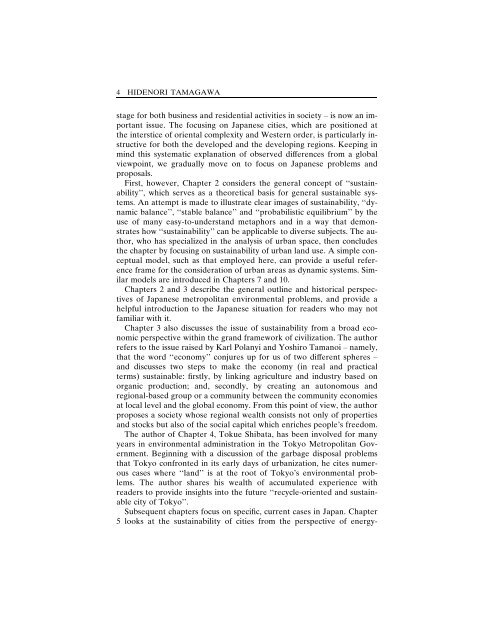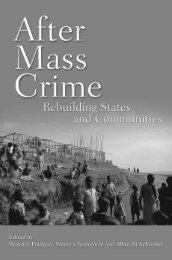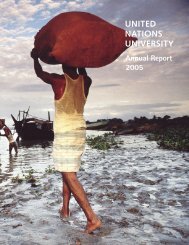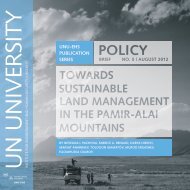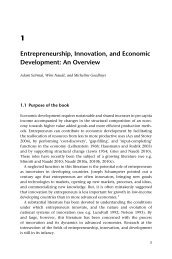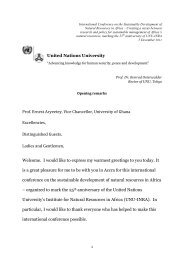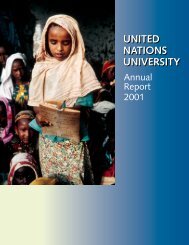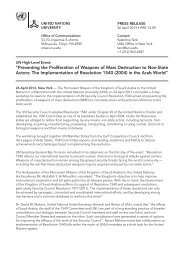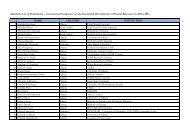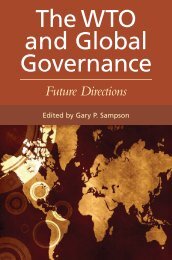Edited by Hidenori Tamagawa - United Nations University
Edited by Hidenori Tamagawa - United Nations University
Edited by Hidenori Tamagawa - United Nations University
Create successful ePaper yourself
Turn your PDF publications into a flip-book with our unique Google optimized e-Paper software.
4 HIDENORI TAMAGAWAstage for both business and residential activities in society – is now an importantissue. The focusing on Japanese cities, which are positioned atthe interstice of oriental complexity and Western order, is particularly instructivefor both the developed and the developing regions. Keeping inmind this systematic explanation of observed differences from a globalviewpoint, we gradually move on to focus on Japanese problems andproposals.First, however, Chapter 2 considers the general concept of ‘‘sustainability’’,which serves as a theoretical basis for general sustainable systems.An attempt is made to illustrate clear images of sustainability, ‘‘dynamicbalance’’, ‘‘stable balance’’ and ‘‘probabilistic equilibrium’’ <strong>by</strong> theuse of many easy-to-understand metaphors and in a way that demonstrateshow ‘‘sustainability’’ can be applicable to diverse subjects. The author,who has specialized in the analysis of urban space, then concludesthe chapter <strong>by</strong> focusing on sustainability of urban land use. A simple conceptualmodel, such as that employed here, can provide a useful referenceframe for the consideration of urban areas as dynamic systems. Similarmodels are introduced in Chapters 7 and 10.Chapters 2 and 3 describe the general outline and historical perspectivesof Japanese metropolitan environmental problems, and provide ahelpful introduction to the Japanese situation for readers who may notfamiliar with it.Chapter 3 also discusses the issue of sustainability from a broad economicperspective within the grand framework of civilization. The authorrefers to the issue raised <strong>by</strong> Karl Polanyi and Yoshiro Tamanoi – namely,that the word ‘‘economy’’ conjures up for us of two different spheres –and discusses two steps to make the economy (in real and practicalterms) sustainable: firstly, <strong>by</strong> linking agriculture and industry based onorganic production; and, secondly, <strong>by</strong> creating an autonomous andregional-based group or a community between the community economiesat local level and the global economy. From this point of view, the authorproposes a society whose regional wealth consists not only of propertiesand stocks but also of the social capital which enriches people’s freedom.The author of Chapter 4, Tokue Shibata, has been involved for manyyears in environmental administration in the Tokyo Metropolitan Government.Beginning with a discussion of the garbage disposal problemsthat Tokyo confronted in its early days of urbanization, he cites numerouscases where ‘‘land’’ is at the root of Tokyo’s environmental problems.The author shares his wealth of accumulated experience withreaders to provide insights into the future ‘‘recycle-oriented and sustainablecity of Tokyo’’.Subsequent chapters focus on specific, current cases in Japan. Chapter5 looks at the sustainability of cities from the perspective of energy-


